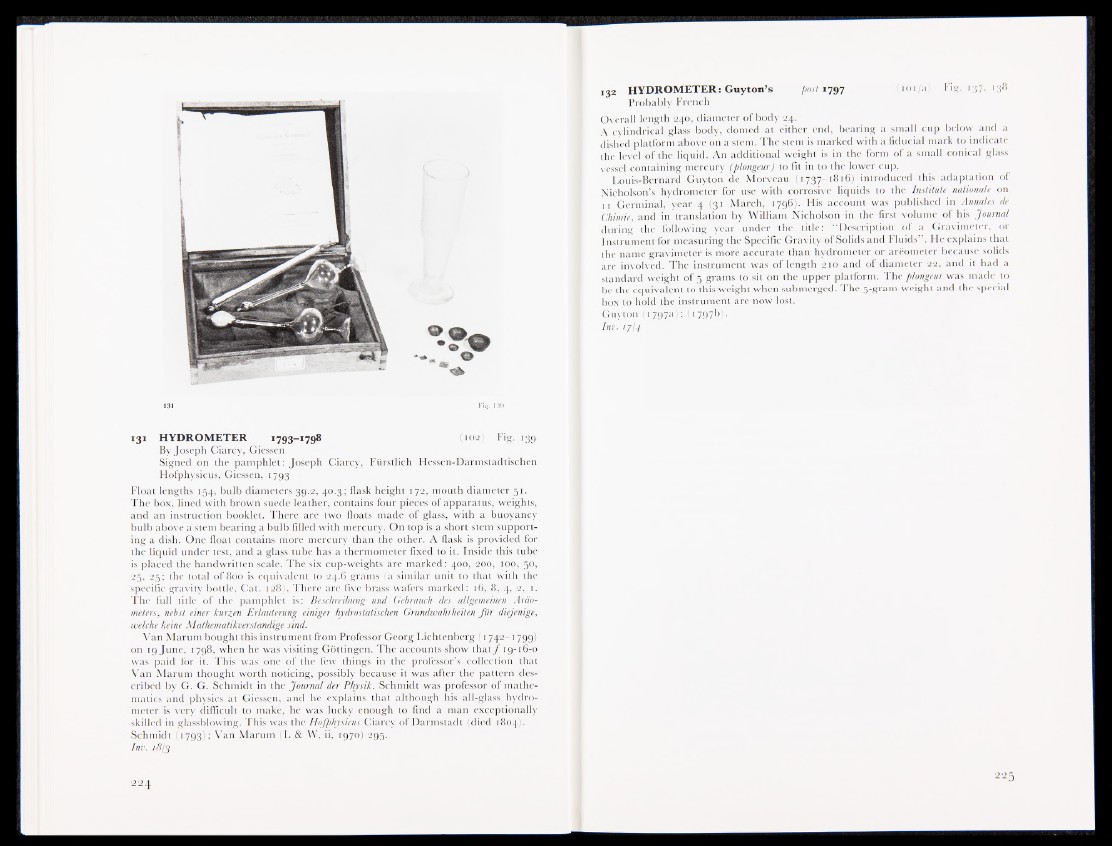
131 Fig. 139
131 HYDROMETER 1793-1798 (slip Fig. 139
By Joseph Ciarcy, Giessen
Signed on the pamphlet: Joseph Ciarcy, Fürstlich Hessen-Darmstadtischen
Hofphysicus, Giessen, 1793
Float lengths 154, bulb diameters 39.2, 40.3; flask height 172, mouth diameter 51.
The box, lined with brown suede leather, contains four pieces of apparatus, weights,
and an instruction booklet. There are two floats made of glass, with a buoyancy
bulb above a stem bearing a bulb filled with mercury. On top is a short stem supporting
a dish. One float contains more mercury than the other. A flask is provided for
the liquid under test, and a glass tube has a thermometer fixed to it. Inside this tube
is placed the handwritten scale. The six cup-weights are marked: 400, 200®00, 50,
25, 25; the total of 800 is equivalent to 24.6 grams: fa similar unit to that with the
specific gravity bottle, Cat. 128). There are five brass wafers marked: 16, 8, 4,- g,,. 1.
The full title of the pamphlet Hfe Beschreibuïïg- und Gebraucnwd.es allgemeinen Aräometers,
nebst einer kurzen Erläuterung einiger hydrostatischen Grundwahrheiten für diejenige,
welche keine Mathematikverstandige sind.
Van Marum bought this instrument from Professor Georg Lichtenberg (1742—1799)
on 19 June, 1798, when he was visiting Göttingen. The accounts show that f 19-16-0
was paid lor it. This was one of the few things in the professor’s ‘Sllection that
Van Marum thought worth noticing, possibly because it was after the pattern described
by G. G. Schmidt in the Journal der Physik. Schmidt was professor of mathematics
and physics at Giessen, and he explains that although his all-glass hydrometer
is very difficult to make, he was lucky enough to find a man exceptionally
skilled in glassblowing. This was the Hofphysicus Ciarcy of Darmstadt: (died : 804).
Schmidt (1793); Van Marum (L & W, ii,B97oj 295,
Inv. i8Ij
132 HYDROMETER: Guyton’s post 1797 101 /a
Probably French
Fig. 137, 138
Overall length 240, diameter of body 24.
A cylindrical glass body, domed at either end, bearing a small cup below and a
dished platform above on a stem. The stem is marked with a fiducial mark to indicate
the level of the liquid. An additional weight is in the form of a small conical glass
vessel containing mercury (plongeur) to fit in to the lower cup.
Louis-Bernard Guyton de Morveau (1737-1816) introduced this adaptation of
Nicholson’s hydrometer for use with corrosive liquids to the Institute nationale on
11 GerminaMyear 4 (31 March, 17968 His account was published in Annales de
Chimie, and in translation by William Nicholson in the first volume of his Journal
during the follow ing year under the title: “ Description of a Gravimeter, or
Instrumentfor measuring the Specific Gravity of Solids and Fluids” . He explains that
the name gravimeter is more accurate than hydrometer or areometer because solids
are involved. The instrument was of length 210 and of diameter 22, and it had a
standard weight of 5 grams to sit on the upper platform. The plongeur was made to
be thptequivalent to this weight when submerged. The 5-gram weight and the special
box to. hold the instrument are now lost.
Guyton (1797a); (1797b)'.'.)